Key takeaways:
- Sustainable irrigation methods, such as drip irrigation and rainwater harvesting, significantly conserve water and improve soil health while reducing reliance on traditional water sources.
- Water conservation is essential for addressing global water scarcity, protecting ecosystems, and enhancing economic efficiency in agriculture and communities.
- Real-world case studies showcase the transformative effects of adopting innovative irrigation techniques, leading to improved crop yields, environmental benefits, and enhanced community resilience.
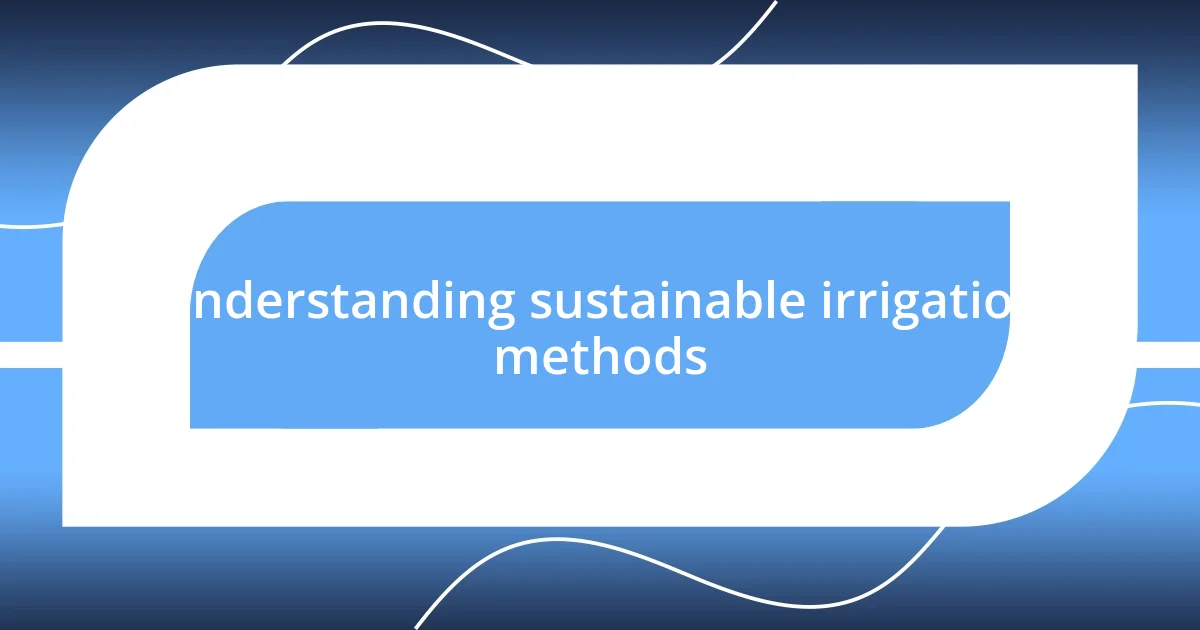
Understanding sustainable irrigation methods
When I first delved into sustainable irrigation methods, I quickly realized that it’s not just about conserving water; it’s about nurturing our environment and future. For instance, techniques like drip irrigation deliver water right to the plant’s roots, minimizing waste. Have you ever watched a garden flourish with just the right amount of moisture? It’s mesmerizing how plants respond when they’re cared for wisely.
Exploring sustainable practices also opened my eyes to the importance of soil health. Healthy soil retains water more effectively, which means less frequent irrigation is needed. I remember visiting a local farm that used cover crops, and seeing how the soil was alive with worms and organic material. It made me think: how often do we pause to consider what lies beneath the surface of our gardens?
There’s also an exciting connection with technology in sustainable irrigation. Innovations like smart sensors monitor soil moisture levels, ensuring plants get exactly what they need. I find it fascinating to think about how, just a few years ago, this was merely a dream. Isn’t it thrilling to witness such progress in our approach to farming and gardening?
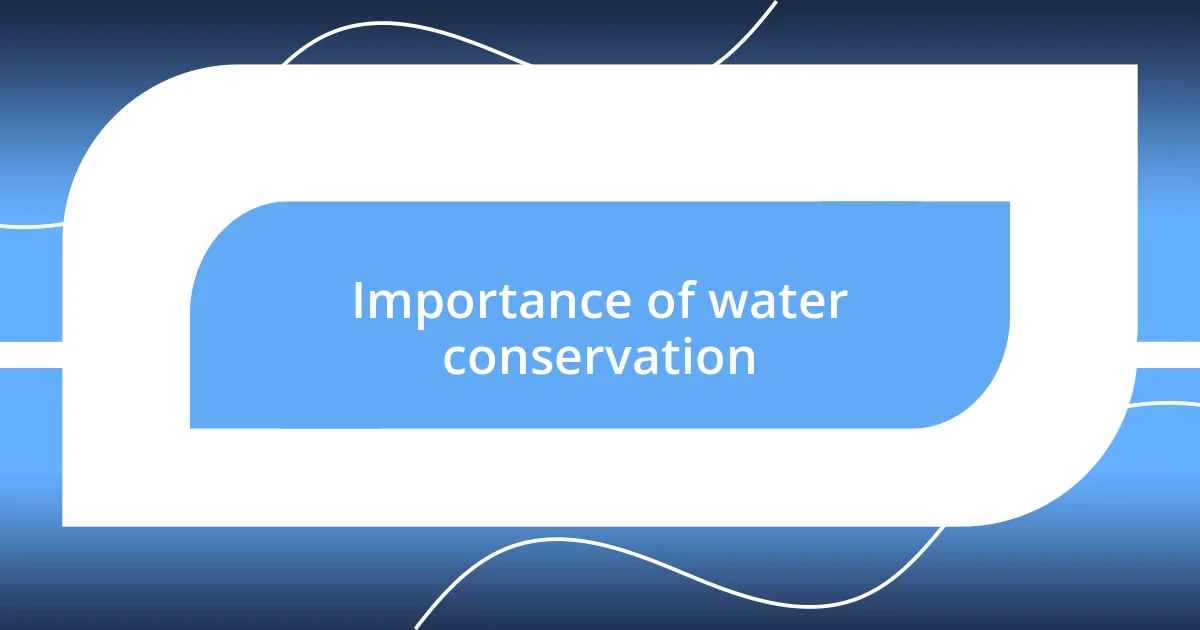
Importance of water conservation
Water conservation is not just a necessity; it’s a commitment to the future of our planet. I recall a hot summer day when I stood in my parched garden, only to realize how precious every drop truly is. That moment instilled in me the understanding that every small action can make a difference. The reality is that as we face increasing water scarcity, our responsibility to conserve becomes ever more critical.
Here are some key reasons why water conservation is vital:
- Threat of Water Scarcity: With global populations rising, the demand for freshwater is outpacing supply.
- Environmental Impact: Conserving water helps protect ecosystems, ensuring that streams, rivers, and lakes remain healthy.
- Economic Benefits: Reduced water usage can lead to lower utility bills and increased efficiency in agriculture.
- Soil Health: Efficient water use fosters better soil conditions, promoting healthier plants and crops.
- Climate Resilience: Conserving water helps communities become more resilient to climate change, mitigating the effects of droughts and extreme weather.
Every time I turn off the tap while brushing my teeth, I’m reminded that these small changes reflect a larger movement toward sustainable living. It’s those little actions that compound over time, and I believe we can start a ripple effect within our communities.
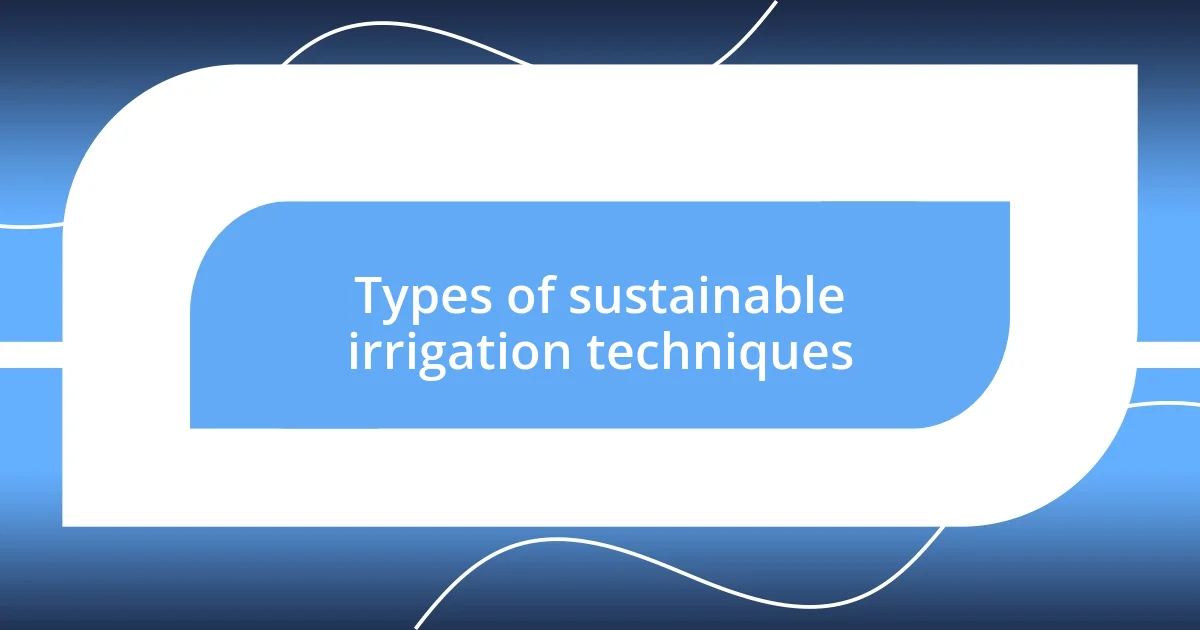
Types of sustainable irrigation techniques
Sustainable irrigation techniques offer various solutions to meet our agricultural needs while protecting valuable resources. Drip irrigation stands out as a prime example, allowing water to trickle directly to plant roots. When I first witnessed this method in action, I couldn’t help but appreciate the sheer brilliance of it; the efficiency of water use is extraordinary! It reminded me of my grandmother’s garden, where she meticulously watered her plants and nurtured them like family. Seeing plants thrive with just the right moisture was a lesson in balance.
Another method worth noting is rainwater harvesting, which captures and stores rainwater for later use. I recall my buddy converting his rooftop into a rain garden last year. Watching that water collection system fill up during a downpour was such a thrill! Suddenly, he didn’t need to reach for the hose to irrigate his vegetables. It felt rewarding to witness how harnessing nature’s gifts can create a sustainable cycle.
Finally, there’s the practice of furrow irrigation, which uses shallow trenches to direct water. While not as high-tech as some other methods, it efficiently captures water for crop roots. I remember a visit to a local farm where the farmer explained this technique with such enthusiasm. He shared how this traditional method, when paired with soil health practices, could maximize crop yield while minimizing water use. It made me realize that sustainability can often be found in both innovation and tradition.
| Technique | Description |
|---|---|
| Drip Irrigation | Delivers water directly to plant roots, minimizing waste and maximizing efficiency. |
| Rainwater Harvesting | Captures and stores rainwater for irrigation, reducing reliance on municipal water sources. |
| Furrow Irrigation | Uses shallow trenches to direct water to crops, enhancing water capture and reducing evaporation. |
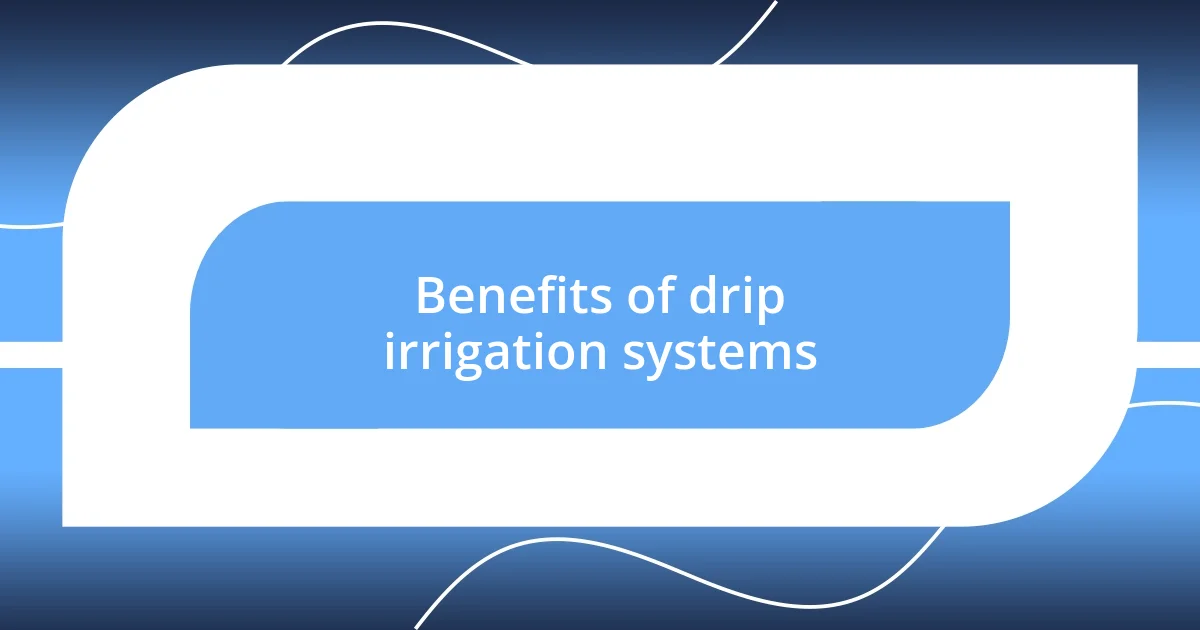
Benefits of drip irrigation systems
The benefits of drip irrigation systems are impressive and transformative. One of my favorite aspects is how it minimizes water wastage. I recall helping a neighbor install a drip system in her backyard. Watching the water seep gently into the soil was like witnessing a perfectly balanced dance; each drop mattered, nurturing her plants without the usual flood. This method can save up to 60% more water compared to traditional irrigation!
Additionally, drip irrigation contributes significantly to healthier plants. When I first started my own garden, I noticed that the plants receiving drip irrigation were not only thriving but seemed more vibrant than others. It became clear that delivering water directly to the roots helped eliminate issues like leaf rot and fungal diseases — who would have thought a simple setup could make such a difference?
One might wonder about the initial costs of setting up drip irrigation systems, but the long-term savings are worth every penny. After my experience installing a system, I realized the reduction in water bills and increased crop yield were truly rewarding. Isn’t it fascinating how investing in sustainable practices can bring both financial and environmental returns? It’s a win-win for the gardener and the planet alike!
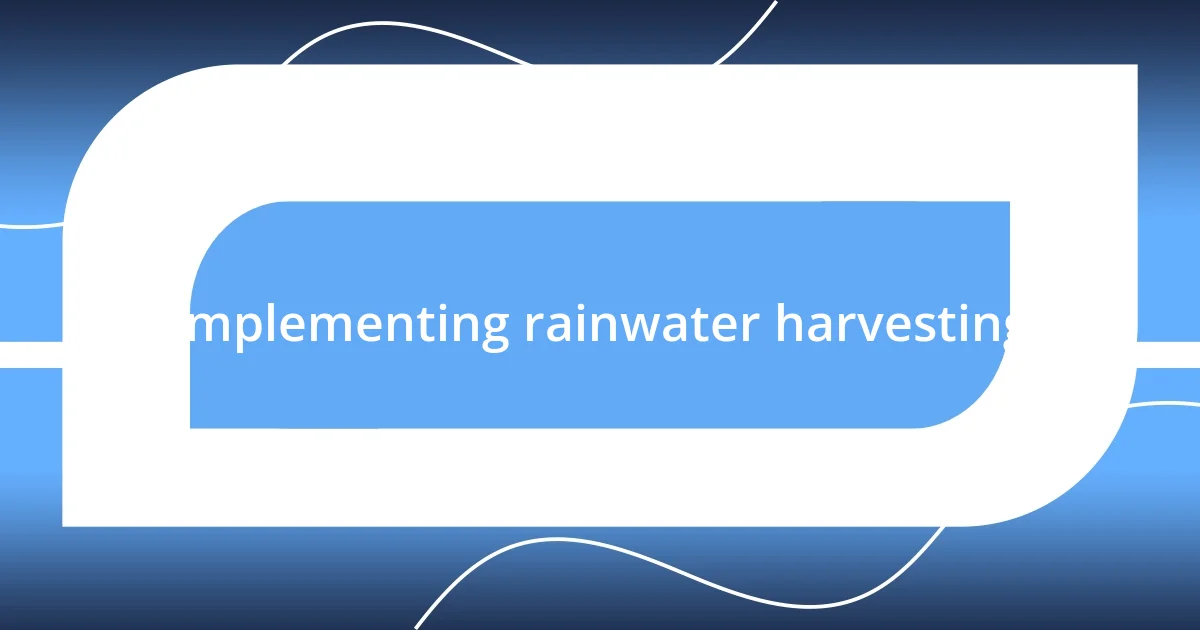
Implementing rainwater harvesting
One of the most fulfilling experiences I’ve had involved setting up a rainwater harvesting system at my own home. It was thrilling to watch the first rainstorm fill up the barrels I had carefully positioned. Each drop seemed to echo the potential stored in that water, waiting to nourish my plants later. It made me wonder—what if everyone embraced this natural resource?
Understanding how to implement rainwater harvesting can feel daunting at first, but it’s often simpler than one might think. I remember reflecting on the day I installed my first system. I used a few basic materials: gutters, a downspout, and some old barrels. The simplicity of the setup was humbling. With every rain, I felt a rush of satisfaction, knowing I was taking a step towards sustainability while benefiting my garden—a true blend of utility and responsibility.
In addition to providing water for irrigation, collecting rainwater also reduces runoff, which can harm local waterways. As someone who enjoys nature, this resonates with me deeply. It’s like playing a small part in preserving the environment. When I see the barrels fill up during the rainy season, I remind myself that this small effort contributes towards reducing reliance on municipal water sources. Aren’t we all searching for ways to make a more significant impact with less effort?
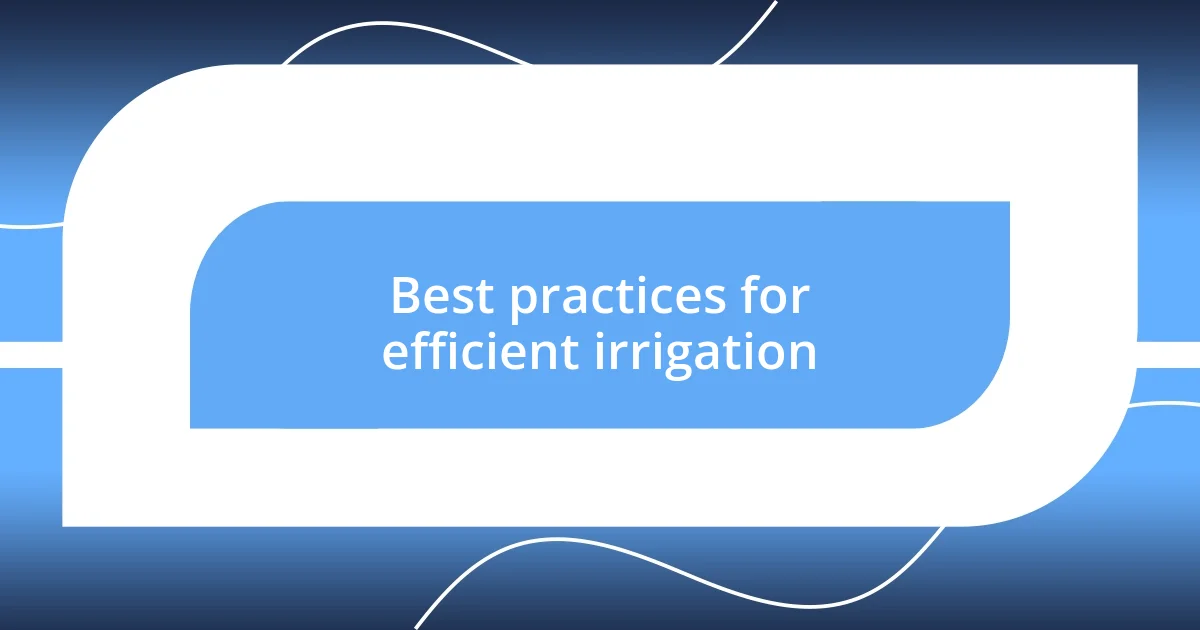
Best practices for efficient irrigation
Implementing efficient irrigation practices requires a keen understanding of timing and methods. I remember the early mornings in my garden, when I would water before the sun peaked. The moisture evaporates less, ensuring that more is available for my plants. Doesn’t it make sense to take advantage of cooler temperatures to save water?
Another practice I’ve adopted is to regularly monitor soil moisture levels. I invested in a simple moisture meter, and wow, what a game changer! Before I used it, I often over-watered, thinking I was being diligent. Now, I check the soil first, and it feels like I’ve finally been let in on a little secret. By adjusting my watering schedule based on moisture levels, I’ve not only reduced my water use but also nurtured healthier plants.
Lastly, incorporating mulch into my garden has proven invaluable. After learning from a gardening workshop, I decided to apply organic mulch around my plants. The transformation was remarkable; it retained moisture and kept the roots cool. I often find myself pondering how simple additions can lead to significant results. Isn’t it inspiring that with a few adjustments, we can create thriving ecosystems while being kinder to our planet?
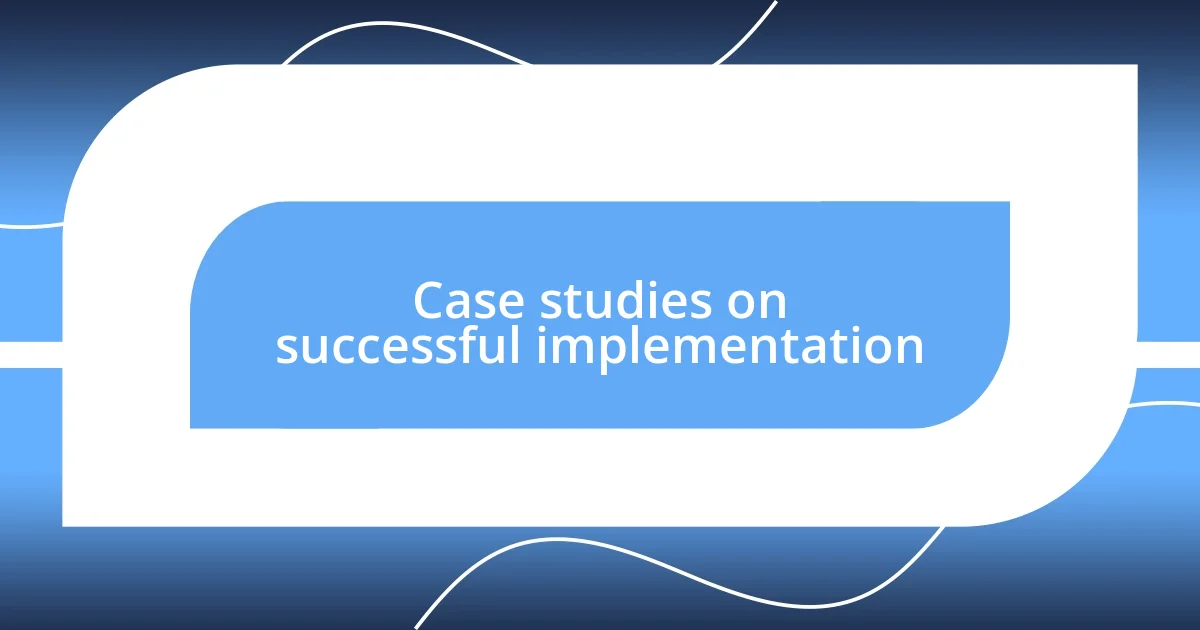
Case studies on successful implementation
Consider the case of a community in California that adopted drip irrigation in their agricultural practices. As a local farmer shared with me, switching from traditional flood irrigation to this method was transformative. Not only did water usage drop significantly, but the health of the crops improved remarkably, leading to increased yields. Doesn’t it bring a sense of fulfillment to know that innovation can come from something as simple as a hose with emitters?
Another inspiring example comes from a nonprofit project in Kenya that introduced solar-powered micro-irrigation systems. I remember reading firsthand accounts from the farmers involved. They described how, equipped with this technology, they could irrigate their fields more efficiently, even during dry seasons. The smiles on their faces, as they shared stories of improved harvests and food security, painted a vivid picture of the impact sustainable methods can have on communities.
In Australia, a vineyard embraced rainwater harvesting to achieve sustainability goals. Listening to the vineyard owner recount the experience was incredibly insightful. By collecting runoff water from their roofs and storing it in large tanks, they not only reduced their dependency on groundwater but also enhanced the quality of their wine. Who would have thought that a simple infrastructure change could elevate product quality while fostering environmental stewardship?












